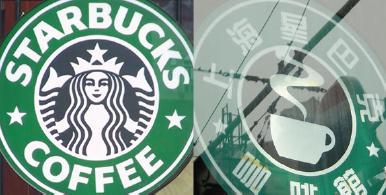The December 2007 issue of China Intellectual Property magazine had a nice write-up about the Starbucks Corp. v. Shanghai Xingbake Cafe Corp. Ltd. trademark infringement case that Shanghai’s No. 2 Intermediate People’s Court decided last year. The case (which STL discussed here) was important because it was the first time China’s new Trademark Law had been applied to a famous trademark.

Starbucks and Xingake logos
Photo credit: East Midlands China Business Bureau
Besides the detailed summary of the case, what I found most interesting was its explanation as to how the court calculated its RMB 500,000 ($64,000) damages award. Here’s an excerpt:
“The compensation claimed by the plaintiffs totalled RMB 1,060,000 including RMB 500,000 for economic losses and RMB 560,000 for reasonable expenses and legal fees. The defendants argued that the calculation of the plaintiffs’ profits was groundless, and thus should not be admitted. The defendants had no objection to the manner of collecting the notarization fee and legal fees, but held that the defendants’ lawyers spent too much time in collecting evidence proving the trademarks were well-known.
“The court held that it was on the basis of the profits made by the defendants from the infringement that the plaintiffs claimed compensation for economic losses. The amount of profits was calculated on the basis of the notarized statistics of the defendants’ customer volume. Although some factors on the formation of the defendants’ profits were taken into account at the time of calculation, the said amount is not completely objective and reasonable. Therefore, the court did not adopt this calculation for determining the amount of profits. The claim of the plaintiffs should be upheld for the retainer, notarization fee and translation fee as well as other fees. In the present case, the defendants committed trademark infringement and unfair competition. The overlapping parts should not be calculated repeatedly in the determination of compensation. Since it was hard to determine the profits made by the two defendants from the infringement and the losses suffered by the two plaintiffs from the infringement, the compensation should be lawfully determined as RMB 500,000 in view of the specific circumstances.”
The article’s author, Lv Guoqiang, should know what he is talking about. He is vice president of the Shanghai No. 2 Intermediate People’s Court.